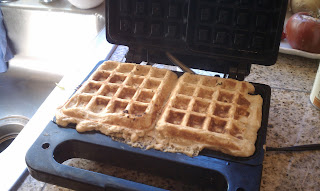Speaking of yum: basil butternut squash green chili enchiladas. It’s quite a mouthful but without one of the three things, I am afraid the title would be understated. These are adapted from my mother’s fantastic chicken enchiladas. And, of course you could use chicken in place of the butternut squash, but I find the heat of chilies paired with the sweetness of the squash to be quite delicious, but feel free to experiment! I grew up eating the chicken enchiladas at least couple times a month and they are fantastic as is. :)
Basil Butternut Squash Green Chili Enchiladas
Makes about 2 pans of enchiladas
1. In a large bowl add and let sit:
- 3-4 oz. of cream cheese
- 1 chopped onion
- 1 c. of your favorite sharper cheese, shredded. I used the Beecher’s raw variety.
- 2-3 T. of dried basil (you can use fresh, but I actually prefer dried here)
- 4-6 oz. of sour cream
- 1 finely chopped poblano chili
- 1 c. of roasted green chilies (you can either do this yourself by roasting several green chilies, letting them cool, removing the skins and dicing, or using a can of diced green chilies. The Hatch brand is one I have used in the past, but this time I roasted the chilies which was super easy. If you do roast the green chilies yourself, make a fair amount, because about half will be used to go in the enchiladas and the other half will be blended for the sauce that goes on top.)

Cubed Butternut Squash (pre-cooking)
 |
| Mixture of butternut squash, basil, chilies etc. |
3. Add butternut squash to the mixture in the large bowl. Season with some cayenne, salt and pepper to taste.
4. Fill each tortilla (you will need about 10-12 tortillas, so plan accordingly) with an ample helping of the mixture, roll up and place in an oiled baking dish.
 |
| Filing size |
5. Once filled pour 1-2 c. of blended green chili sauce over the top. (You can make the sauce yourself, like mentioned above, or you can “cheat” with a can of green chili sauce. No judgment, which method you use, just know that there are some additives to the chilies and the enchilada sauce that I would not know how to cook with.)
6. Bake at 350 for an hour. About 10 min. before they are done, sprinkle a little leftover cheese, or if you have a cotija, use a little to melt on top.
 |
| Pan #1 of said delicious enchiladas |
Bon Appétit!
Tastes: The competing flavors balance nicely with the heat and sweetness.
Total Prep/Cooking Time: 45 min to roast the green chilies, remove the skins and either dice or blend; 30-40 min for the butternut squash to cook (which could be cooked at the same time as the chilies); 15 min to chop, mix and assemble the enchiladas and 1 hour to cook. Perfect for a dinner when you have other things you are trying to get done around the house.
Total Cost: Exactly $33.71.
As I sat down to write this entry, I realized it has been over a month since I last wrote. For those that are interested in my life outside of writing about, shopping for, cooking, and consuming food, I am happy to report that I landed a new job at the end of October with a small hedge fund here in Seattle. While no job is ideal (because let’s be honest, I don’t know many people actually interested in sitting in an office for 12+ hours a day), it is pretty much exactly the job I wanted when I made the decision to go back to graduate school. It wasn’t wrapped in the beautiful bow that I envisioned and lusted after, but here I am doing what I set out to do. I am hoping I can survive for the time being, learn a ton and eventually see myself going into business independently- rather it will be in food or finance, or potentially both. It has been a really interesting month adjusting to the position, the pace of the office and finding balance in my new life. Because learning about, writing about and cooking food are incredibly important to me, I am going to try and write as much as I can and if there is anything you are interested in learning about or wanting me to test out, please let me know. :) Until next time, happy eating (and investing)!





















